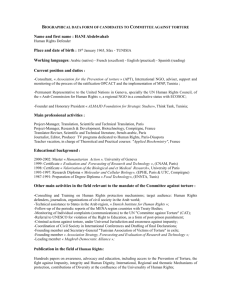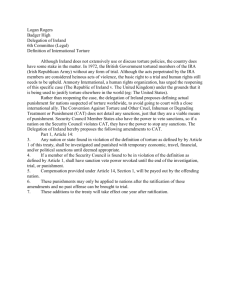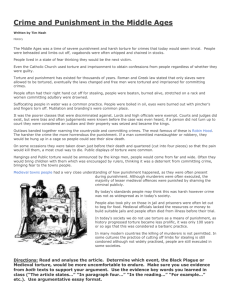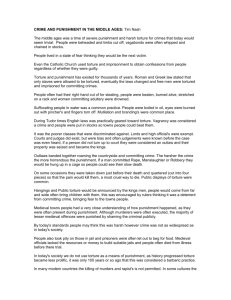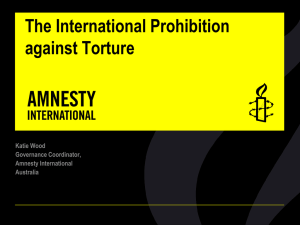MS Word format - Historians Against the War
advertisement
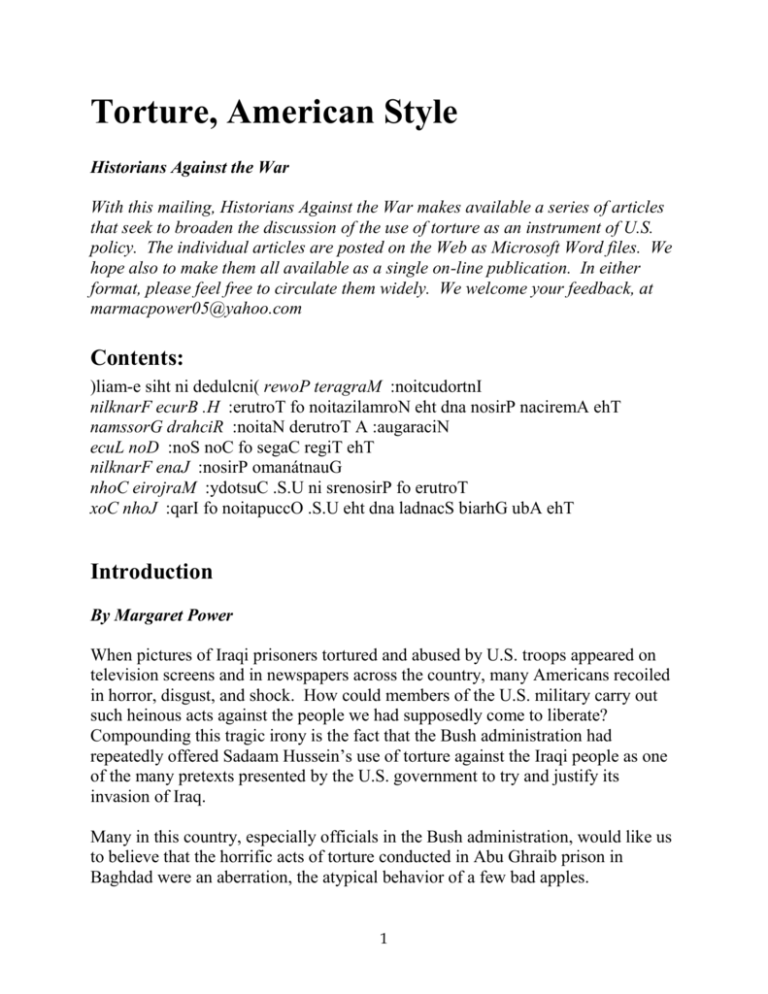
Torture, American Style Historians Against the War With this mailing, Historians Against the War makes available a series of articles that seek to broaden the discussion of the use of torture as an instrument of U.S. policy. The individual articles are posted on the Web as Microsoft Word files. We hope also to make them all available as a single on-line publication. In either format, please feel free to circulate them widely. We welcome your feedback, at marmacpower05@yahoo.com Contents: )liam-e siht ni dedulcni( rewoP teragraM :noitcudortnI nilknarF ecurB .H :erutroT fo noitazilamroN eht dna nosirP naciremA ehT namssorG drahciR :noitaN derutroT A :augaraciN ecuL noD :noS noC fo segaC regiT ehT nilknarF enaJ :nosirP omanátnauG nhoC eirojraM :ydotsuC .S.U ni srenosirP fo erutroT xoC nhoJ :qarI fo noitapuccO .S.U eht dna ladnacS biarhG ubA ehT Introduction By Margaret Power When pictures of Iraqi prisoners tortured and abused by U.S. troops appeared on television screens and in newspapers across the country, many Americans recoiled in horror, disgust, and shock. How could members of the U.S. military carry out such heinous acts against the people we had supposedly come to liberate? Compounding this tragic irony is the fact that the Bush administration had repeatedly offered Sadaam Hussein’s use of torture against the Iraqi people as one of the many pretexts presented by the U.S. government to try and justify its invasion of Iraq. Many in this country, especially officials in the Bush administration, would like us to believe that the horrific acts of torture conducted in Abu Ghraib prison in Baghdad were an aberration, the atypical behavior of a few bad apples. 1 Unfortunately, this is not the case. As the articles in this pamphlet show, the use of torture by the U.S. government and citizens has a long and sordid history both in the United States and abroad. This pamphlet is not an exhaustive study of the use of torture; it focuses specifically on cases of torture conducted by U.S. citizens furthering policies sanctioned by the U.S. state.(1) Bruce Franklin's article, “The American Prison and the Normalization of Torture,” shows how the American prison system developed into a central institution of U.S. society, one that has made torture routine and acceptable. The physical, mental, and sexual abuse glimpsed at Abu Ghraib is part of the daily experience for two million people caged in American prisons, while most of the rest of the American public acquiesces or denies the reality of this torture. Don Luce’s essay, “The Tiger Cages of Con Son,” reveals again, as did his original testimony in the 1970s, the depths to which the U.S. government sank in its ultimately futile efforts to defeat the Vietnamese people. It imprisoned those Vietnamese it considered “the enemy” in tiger cages, subjected them to physical abuses, deprived them of food and water, and, as if all that was not bad enough, poured lye on them to burn and scar them. Jane Franklin's “Guantánamo Prison” reveals how Washington's forced occupation of Cuban territory a century ago has led to its logical conclusion – a prison. Used first for Haitians and Cubans and then for captives of the “War on Terror,” the U.S. military base has become a crucible for torture exported to Afghanistan and Iraq. Marjorie Cohn’s article, “Bush & Co.: War Crimes and Cover-Up,”(2) asks why the torture story has virtually disappeared from the media and much of the public consciousness. To answer this question, she examines the inner machinations of the Bush administration and the history of its discussions and directives on torture. John Cox’s article, “The Abu Ghraib Scandal and the U.S. Occupation of Iraq,” accomplishes several critical goals. It succinctly summarizes the history of the scandal at Abu Ghraib and the investigations into it and discusses who is responsible for the abuses. Cox also makes the important point that much of the U.S. media coverage of the abuse has ignored the torture of women and children that took place at Abu Ghraib, the details of which are particularly horrible. Probably the one area of the world where the U.S. government has most engaged in the use of torture is Latin America. Torture was integral to U.S. foreign policy in Latin America, as Richard Grossman’s article, “Nicaragua: A Tortured Nation,” 2 illustrates. The infamous School of the Americas trained key Latin American military officers and troops, some of whom ushered in the brutal military dictatorships that presided over their countries from the 1960s to the 1990s.(3) In addition, as Grossman points out, members of the U.S. marine force that occupied Nicaragua in the early 20th century did not just teach the Nicaraguan Guardia how to torture, they also engaged in it themselves as part of their efforts to terrorize Nicaraguans and defeat Augusto Cesar Sandino and his anti-imperialist forces. The U.S. government’s sponsorship of torture was not limited to the training of Latin American militaries. As A. J. Langguth details in Hidden Terrors, the U.S. government also worked directly with police forces throughout the continent. His book discusses the work of Dan Mitrione, a police chief from Richmond, Indiana, who instructed the Uruguayan police force in methods of torture in the late 1960s.(4) State of Siege by Costas-Garvas dramatically brings to the screen the story of Dan Mitrione, the anti-democratic methods of coercion and repression he taught the Uruguayan police force, and his subsequent kidnapping and execution by the Tupamaros, the Uruguayan guerrilla force. Uruguay was not an isolated example, as Martha Huggins shows in her exposé of the U.S. government training of police forces in Latin America, with a particular focus on Brazil.(5) In order to inflict pain on people, the torturer needs to transform the tortured into the Other, in most cases the enemy Other. During the Cold War, the U.S. government convinced many people in this country and around the world that “communists,” a blanket term applied to those who espoused socialism as well as to people who opposed U.S. imperialist control of their nations were the enemy. Today, the enemy Other is the terrorist, who is frequently conflated with the Muslim or Arab Other. To be an Other means to be a fanatic, to be impervious to “our” morality and values; in short, to be not only less than human, but far from human, a living machine who is definitely not one of US (the definition of who US is, is seldom clear). Since this person is not one of us, and is, in fact, intent on destroying US, then WE can use whatever means are available to counter this evil force. It is within this context that torture is not only allowed, it is approved. Some believe that those who torture do so simply to extract information from the captured enemy. This is not entirely true, as the examples of Abu Ghraib, the tiger cages in Vietnam, and the treatment of slaves and prisoners in this country show so clearly. Torture is used to degrade, humiliate, and destroy both the individual who is being abused and members of his or her community who care about and feel connected to the victim of torture. It is a weapon used by those in power to maintain themselves in power. 3 The explicit use of sexual abuse in Abu Ghraib has horrified many people, perhaps more than any of the other methods of torture employed. Homophobia and the revulsion with which many Americans and Iraqis view same-sex relationships clearly shaped the sexual tortures the U.S. military officials inflicted on their prisoners. U.S. Guards forced male Iraqi prisoners to masturbate, wear female underclothes, and perform fellatio on each other.(6) That particular method of torture was used to damage, perhaps obliterate, the tortured individual’s sense of self, his or her very identity. Such practices undermine an individual’s will to resist and weaken a community’s ability to survive. And that was exactly the point. The torture of Iraqis, like the abuse of the prisoners in Guantánamo and Vietnam, or the slaves in the U.S. south was a logical, if immoral, extension of U.S. state policy. The U.S. government invaded Iraq, as it had invaded Vietnam and Afghanistan, and as slaveholders had enslaved Africans. Those who were and are the victims of occupation--either of their nations or their bodies--resisted, just as the Iraqis continue to resist. In order to crush opposition, U.S. government policymakers and citizens alike employed torture in an effort to destroy the spirit of resistance and make the people's defeat seem inevitable. We know there are many people in this country who are appalled and disgusted by the use of torture. The courageous actions of Joseph Darby helped bring to light the abuse of prisoners at Abu Ghraib, just as three decades before the efforts of Don Luce and Tom Harkin helped to expose the criminal treatment of Vietnamese prisoners at Con Son. We hope that all of you who read this pamphlet will condemn any and all forms of torture and raise your voice to oppose its use, any time and anywhere. Notes 1. There are many other examples of U.S. government torture whose story needs to be told. If you know of other examples and/or would like to write about them, please contact me, Margaret Power, at marmacpower05@yahoo.com. 2. Her article was originally printed in Truthout/Perspective, September 20, 2004. 3. William Blum, The CIA, A Forgotten History, London: Zed Books, 1986. 4. A. J. Langguth, Hidden Terrors, New York: Pantheon Books, 1978. 5. Martha K. Huggins, Political Policing: The United States and Latin America, Durham: Duke University Press. 6. New York Times, October 7, 2004. 4 Margaret Power is an anti-war activist and Associate Professor of History at the Illinois Institute of Technology. She is the author of Right-Wing Women in Chile: Feminine Power and the Struggle against Allende and co-editor with Paola Bacchetta of RightWing Women: From Conservatives to Extremists around the World. Her current research projects include modernity, gender, and technology in Chile, 1964 to 2000 and the Latin American right after 1945. Contact her at marmacpower05@yahoo.com 5



